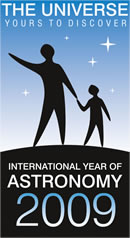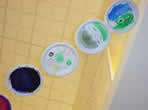 What's at Risk?
What's at Risk?
In this activity the student draws on a paper plate what he/she sees and values about the night and then suspends the artwork overhead. This captured impression is what is at risk of being lost because of light pollution.
To mass-produce a starfield of Orion on paper plates for a group, see the "Globe at Night" paper plate activity. This gives you the main stars of the constellation on a plate. Have the students go outside at night to add the remaining stars of Orion that are visible from their home. Next have the students connect the dots to form an image of their choosing.
Caveat: Be careful about insisting on things that the student doesn't see. For example, in the plate at right, the student had heard about the sword of Orion, and drew it on the plate. However, with the sword drawn astride Orion, it does not reflect the traditional placement of the sword to include the famous Orion Nebula. While allowing the artist to break from tradition is welcomed, be cautious about planting misconceptions.
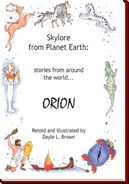 To complement the visual spectacle of Orion, share some of the cultural heritage of this starfield. Dale Brown's book Sky Lore from Planet Earth: stories from around the world...Orion highlights the importance of these stars in world history. A copy of the book is available in the library of every PHM school.
To complement the visual spectacle of Orion, share some of the cultural heritage of this starfield. Dale Brown's book Sky Lore from Planet Earth: stories from around the world...Orion highlights the importance of these stars in world history. A copy of the book is available in the library of every PHM school.
 The depth of Orion extends beyond the visual and mythological traditions. For example, the Orion Nebula--seen as the fuzzy patch below the three Belt Stars--is a fantastic cloud of gas and dust in which stars are being born. Invite the student to look into the science of this stellar nursery, for as the stars and stories become lost in the light pollution, so too does the connection to the science. The image at right compares the view of Orion in visible light with infrared light. A lenticular card of this combined image is available at every PHM school.
The depth of Orion extends beyond the visual and mythological traditions. For example, the Orion Nebula--seen as the fuzzy patch below the three Belt Stars--is a fantastic cloud of gas and dust in which stars are being born. Invite the student to look into the science of this stellar nursery, for as the stars and stories become lost in the light pollution, so too does the connection to the science. The image at right compares the view of Orion in visible light with infrared light. A lenticular card of this combined image is available at every PHM school.
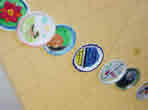
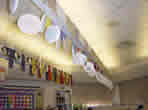 After the student has combined visual, historical, and scientific aspects of the night sky (plus any whimsical additions!) on the plate, display his/her handiwork overhead. One method to display multiple plates is to suspend a string across a room and clip the plates to the string. When one looks up at the plates overhead they will see the multiple aspects of the night sky that are risk of being lost to the infringement of light pollution.
After the student has combined visual, historical, and scientific aspects of the night sky (plus any whimsical additions!) on the plate, display his/her handiwork overhead. One method to display multiple plates is to suspend a string across a room and clip the plates to the string. When one looks up at the plates overhead they will see the multiple aspects of the night sky that are risk of being lost to the infringement of light pollution.
The displayed plates shown here are excerpted from the "Globe at Night" activity, the "Novel Themes" activity, and "Gallery: Prairie Vista 1" at Paper Plate Education. Orion image courtesy of NASA's WISE Mission.
"If we want people to act, they have to be motivated by their own nighttime experience, not ours."
